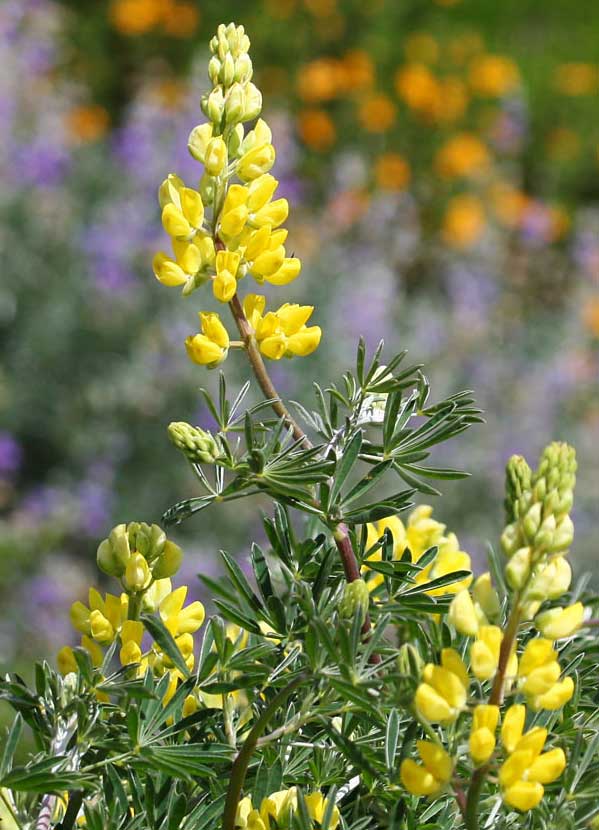
Lupinus arboreus, Photo: nps.gov
[dismiss]
Translation
Wikispecies needs translators to make it more accessible. More info on this page.
Lupinus arboreus
Jump to navigation
Jump to search
Lupinus arboreus
Lupinus arboreus
Taxonavigation
Taxonavigation: Fabales
Classification System: APG IV
Superregnum: Eukaryota
Regnum: Plantae
Cladus: Angiosperms
Cladus: Eudicots
Cladus: Core eudicots
Cladus: Rosids
Cladus: Eurosids I
Ordo: Fabales
Familia: Fabaceae
Subfamilia: Faboideae
Tribus: Genisteae
Genus: Lupinus
Species: Lupinus arboreus
Varieties: L. a. var. arboreus – L. a. var. eximius
Name
Lupinus arboreus Sims, 1803
Synonyms
Lupinus fruticosus Dum.Cours.
Lupinus macrocarpus Hook. & Arn.
Distribution
Native distribution areas:
References
Primary references
Sims, J., 1803. Botanical Magazine; or, Flower-Garden Displayed ... London 17: t. 682.
Links
Govaerts, R. et al. 2021. Lupinus arboreus in Kew Science Plants of the World online. The Board of Trustees of the Royal Botanic Gardens, Kew. Published online. Accessed: 2021 Jan 22. Reference page.
International Plant Names Index. 2021. Lupinus arboreus. Published online. Accessed: Jan 22 2021.
Tropicos.org 2021. Lupinus arboreus. Missouri Botanical Garden. Published online. Accessed: 22 Jan 2021.
Hassler, M. 2021. Lupinus arboreus. World Plants: Synonymic Checklists of the Vascular Plants of the World In: Roskovh, Y., Abucay, L., Orrell, T., Nicolson, D., Bailly, N., Kirk, P., Bourgoin, T., DeWalt, R.E., Decock, W., De Wever, A., Nieukerken, E. van, Zarucchi, J. & Penev, L., eds. 2021. Species 2000 & ITIS Catalogue of Life. Published online. Accessed: 2021 Jan 22. Reference page.
USDA, ARS, Germplasm Resources Information Network. Lupinus arboreus in the Germplasm Resources Information Network (GRIN), U.S. Department of Agriculture Agricultural Research Service. Accessed: 07-Oct-06.
Vernacular names
English: Yellow Bush Lupine
Lupinus arboreus, the yellow bush lupine (US) or tree lupin (UK), is a species of flowering plant in the legume family Fabaceae.
Description
Lupinus arboreus is an evergreen shrub growing to 2 m (7 ft) tall (hence the alternative common name, tree lupine) in sheltered situations, but more typically 1–1.5 m (3–5 ft) tall. It is capable of tolerating temperatures down to −12 °C and living for up to seven years.
It has green to gray-green palmate leaves, with 5–12 leaflets per leaf. The leaflets are 2–6 centimetres (0.79–2.36 in) long, often sparsely covered with fine silky hairs.
In spring it bears many racemes, 30 cm (12 in) long, of fragrant, soft yellow, pea-like flowers.[1][2] Both yellow and lilac to purple flowering forms are known. However, the yellow form is more common, except in the north of the species' range.
Distribution
The shrub is indigenous to California, US,[1][3] where it is widely distributed among coastal sage scrub and sand dunes. Because it has been widely introduced in the state, there is some uncertainty about its native range. It is thought to be native from Point Reyes National Seashore south to San Luis Obispo County.[4]
Invasive species
It has escaped from cultivation to become an invasive species in many areas.[5] Outside of its native range in central and northern coastal California, it can become invasive southwards in Southern California and Baja California, and northwards in the coastal Pacific Northwest and British Columbia. It is an introduced species in western Europe, Australia (a potential noxious weed), New Zealand, the Turkish Anatolian Aegean Region, and southern South America including the Falkland Islands.
Like many members of the Fabaceae, it is an effective fixer of nitrogen in the soil. Where it has been introduced, it changes the chemistry of the soil, and therefore allows other exotics to establish themselves, to the detriment of native plants adapted to low nitrogen levels. It also hybridizes with other lupine species outside its range, such as Lupinus littoralis (seashore lupin) and Lupinus rivularis (riverbank lupin), further endangering the survival of those native ecosystem integrated species.
Lupinus arboreus.jpg
Cultivation
The yellow-flowering form of Lupinus arboreus is widely grown as an ornamental plant, for its attractive flowers in traditional, native plant, and wildlife gardens. It is also used to bind drifting sand dunes. It can be seen growing in cracks in vertical stone walls, due to the sharp drainage.
It has gained the Royal Horticultural Society's Award of Garden Merit.[6]
Related shrub species
In addition to the numerous annual and perennial lupines, some other Lupine species also naturally grow as shrubs, including:[7]
Lupinus chamissonis — Chamisso bush lupine, silver bush lupine
Lupinus albifrons — Bush lupine
Lupinus excubitus — Grape soda lupine
Lupinus longifolius — Longleaf bush lupine
References
Jepson: Lupinus arboreus[permanent dead link]
RHS A-Z encyclopedia of garden plants. United Kingdom: Dorling Kindersley. 2008. p. 1136. ISBN 978-1405332965.
Webb, D.A., Parnell, J. and Doogue, D. 1996. An Irish Flora. Dundalgan Press Ltd. Dundalk.ISBN 0-85221-131-7
Tim Johnson (1999). CRC Ethnobotany Desk Reference. CRC Press. p. 494. ISBN 0-8493-1187-X.
UCDavis.edu: California Invasive Plant Council report on yellow bush lupine
"RHS Plant Selector – Lupinus arboreus". Retrieved 29 October 2020.
Koti.mbnet.fi: Classification of Lupins Archived 2008-10-10 at archive.today
Retrieved from "http://en.wikipedia.org/"
All text is available under the terms of the GNU Free Documentation License

